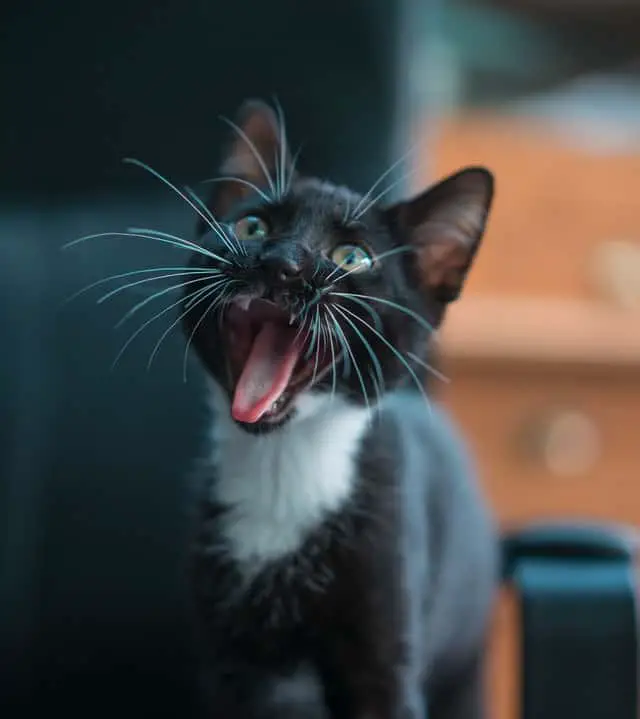Cats use an amazing physical mechanism to drink as much water in the shortest amount of time as possible that fascinates scientists.

How do cats drink? The answer may seem simple: in an elegant way and with almost no noise. However, the mechanism behind the act that allows felines to ingest water is more complicated than it seems, involves several scientific laws, is different from dogs, and intrigues scientists. The mystery is on the tongue of the cat .
The cat’s tongue knows science
Cats know science. Specifically of fluid physics and dynamics, that is, of how liquids work in motion. And this valuable knowledge is used by cats to drink as much water as possible in the shortest time possible.
The cat uses a seemingly simple drinking mechanism that involves fluid physics
The cat uses an interesting physical mechanism to drink based on the ability of water to adhere to its tongue, which plays with the delicate balance between the force of gravity and the inertia of the fluid itself.
The act of drinking may seem simple to those of us who are able to completely close our mouths before beginning to suck the liquid, something that happens in people. However, for species that are not capable of this, such as cats and dogs, the question is complicated: we must find another mechanism.
The cat must overcome the force of gravity to get the water into its mouth, and it must swallow it without closing its jaws. But how do you do it?
Physics helps the cat drink water
Cats soak up the water in their bowl so fast that their owners are unable to detect the fascinating scientific mechanism that unfolds in front of them. Specifically, the cat sips water at the astonishing speed of four times per second .
Contrary to what it might seem, the characteristic roughness of the cat’s tongue , covered with tiny thorns, does little to help the furry friend in the drinking process. This rough surface does serve the feline, on the contrary, to keep its coat clean during grooming.
The physics, and not the spines of the cat’s tongue, is behind the mechanism that allows the furry companion to drink water without problems. The cats have learned to calculate naturally the exact height where the force of gravity, which pushes the liquid toward the ground, is equalized with the chemical and physical forces that hold together the water molecules tongue while drinking. And they use this knowledge to their advantage.
The secret of the cat’s tongue is in science
Science, and not the roughness of the cat’s tongue, allows the feline to drink water
What happens when the furry scientist gets ready to drink? The cat curves its tongue downward, so that the flexible feline muscle creates a pronounced v- shaped arc , allowing the cat to brush only the tip of the tongue against the water in the bowl.
At that precise moment, the cat pushes its tongue upwards at high speed, creating a column of water that adheres to its lower surface. The liquid remains attached to this feline muscle thanks to the balance of forces exerted by inertia and the attractions that arise between the different water molecules and the cat’s tongue.
The cat recognizes the precise moment in which the force of gravity overcomes these attractions and, just at that moment, the cat closes its jaws and swallows the jet of water .
The fascinating thing is that the cat seems to know this mechanism perfectly, since it is able to maximize the amount of water it drinks with each movement of its tongue.
As only the most experienced scientists would, the cat has learned to harness the inertia of the fluid to overcome gravity and pull the water into its mouth. And it is capable of repeating it four times in just one second : too fast to be differentiated by an inexperienced owner with the naked eye.
Dogs and cats don’t drink the same

People are able to close their mouths almost completely and suck to drink water in that position. This apparently simple movement is not, however, common in all mammalian species.
Dogs and cats cannot adopt this position of their jaws while drinking. Therefore, they must resort to other tricks to sip without the liquid escaping.
The upper lines reveal the mystery behind the delicate and efficient way of ingesting water of the felines. This mechanism, based on the adhesion of water to their tongue, is consistent with the fame of delicacies that cats have earned : it allows furry felines to drink with little noise.
Dogs, however, are quite loud when they swallow, especially if they are very thirsty. But why? The explanation is simple: cats and dogs do not drink the same.
While cats have learned to overcome the force of gravity with the help of their tongue – supported by the inertia of the fluid – the mechanism that allows dogs to suck is somewhat less sophisticated.
The dog pushes the water with the help of his tongue and curves the moist and flexible muscle to create a kind of bowl that is filled with liquid by the animal, before being pushed down the throat.
The furry canine friend uses the contact of his entire tongue to cause the displacement of water and capture it on his tongue: therefore it is much louder than the stealthy felines.






